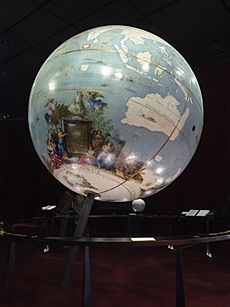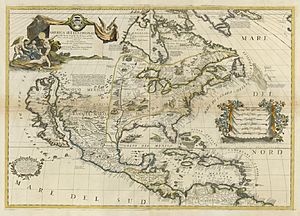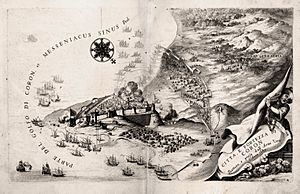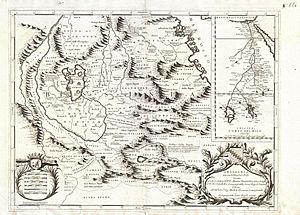Vincenzo Coronelli facts for kids
Vincenzo Maria Coronelli (born August 16, 1650 – died December 9, 1718) was a famous Italian Franciscan friar (a type of monk). He was also a cosmographer (someone who maps the universe), a cartographer (a mapmaker), a publisher, and an encyclopedist (someone who creates encyclopedias). He is best known for his amazing atlases (books of maps) and globes. Vincenzo spent most of his life in Venice, Italy.
Contents
Vincenzo Coronelli's Life Story
Vincenzo Coronelli was likely born in Venice on August 16, 1650. He was the fifth child of Maffio Coronelli, a tailor from Venice. When he was ten, Vincenzo went to Ravenna to become an apprentice to a xylographer (someone who carves wood for printing).
In 1663, he joined the Conventual Franciscans, a religious group. He became a novice (a new member) in 1665. By the time he was sixteen, he had already published his first work! In 1671, he moved to a convent in Venice. A year later, he was sent to a special college in Rome. There, he earned his doctor's degree in theology (the study of religious beliefs) in 1674. He was very good at studying astronomy (the study of stars and planets) and Euclid (a famous mathematician).
Around 1678, Coronelli started working as a geographer (someone who studies the Earth's surface). He was asked to create a pair of globes for the Duke of Parma. One globe showed the Earth, and the other showed the sky. Each globe was very detailed and about five feet (175 cm) wide. The Duke was so impressed that he made Coronelli his theologian. Coronelli became very well-known, and in 1699, he was chosen to be the Father General of the Franciscan order.
Later Years and Achievements
After his time in Rome, Coronelli traveled and worked in different European countries. He finally returned to Venice in 1705. Back home, he started his own big project to map the world. He published many books called Atlante Veneto, which were collections of maps.
In Venice, he also started the very first geographical society, called the Accademia Cosmografica degli Argonauti. He was also given the important job of Cosmographer for the Republic of Venice. Later, he published six volumes of a huge encyclopedia called Biblioteca Universale Sacro-Profana. This encyclopedia had entries listed in alphabetical order.
Vincenzo Coronelli passed away in Venice at the age of 68. He had created hundreds of maps during his lifetime. Today, the International Coronelli Society for the Study of Globes, founded in 1952, is named in his honor.
Globes for the King of France
Cardinal César d'Estrées, a friend and advisor to Louis XIV (the King of France), saw the amazing globes Coronelli made for the Duke of Parma. He invited Coronelli to Paris in 1681 to build an even bigger pair of globes for the King. Coronelli moved to the French capital and lived there for two years.
These globes were huge! Each one was made from long pieces of wood, about ten feet (3 meters) long. These pieces were covered with a thick layer of plaster and then strong fabric. On top of that, two very fine fabrics were added to create a smooth surface for the painted maps. These globes are about 384 cm (almost 13 feet) wide and weigh around 2 tons! They showed the newest information from French explorations in North America, especially the trips made by René-Robert Cavelier, Sieur de La Salle. Today, you can see these incredible globes at the Bibliothèque nationale de France in Paris.
The Bergamo Globes
At first, important people like dukes and kings ordered globes just for themselves. These early globes were often handmade and beautifully decorated. Coronelli was one of the first to create such detailed and artistic globes. His most famous globes fall into two groups. The first group includes the unique globes made for the Duke of Parma and King Louis XIV.
The second group includes globes made after 1688, because Coronelli's work became so famous. People from high society and important institutions wanted his globes. They were not just for science but also as beautiful art for their libraries.
Two of these globes are now in the Salone Furietti of the Angelo Mai Library in Bergamo, Italy. Their story is part of Bergamo's history. The globes arrived in Bergamo in 1692. A friar named Angelo Finardi bought them in Venice to make his monastery's library better. In 1797, the monastery was closed. The globes were almost taken to Paris by Napoleon's army! But a kind nobleman, Giovanni Battista Vertova, hid them in his home in 1834. Later, his son Andrea gave them to the Bergamo Library, where they are today.
Where to Find Coronelli's 110cm Globes Today
Many other Coronelli globes, about 110 cm (43 inches) wide, can be found in different places around the world:
- The National Library of Austria in Vienna has two pairs.
- The Globe Museum in Vienna has a pair.
- The library of Stift Melk in Austria.
- In Trier, Germany.
- In Prague, Czech Republic.
- In Paris, France.
- The British Library in London (a celestial globe only).
- In Washington D.C., USA.
- The Palazzo Poggi in Bologna, Italy (a terrestrial globe only).
- Palazzo Sacchetti in Rome, Italy.
- The Museo della Specola in Bologna, Italy (a terrestrial globe only).
- The Observatory of Strasbourg, France (a celestial globe only).
- A pair at Muzeum Narodowe w Warszawie in Poland.
- Poznań Town Hall in Poland (a terrestrial globe only).
- A pair in the Biblioteca Federiciana in Fano, Italy.
- A restored terrestrial globe at the Southwest Collection/Special Collections Library of Texas Tech University in Lubbock, Texas, USA.
- The Ransom Center at The University of Texas in Austin, USA, has a pair of globes (terrestrial and celestial).
- A pair in the Biblioteca Marciana in Venice, Italy.
- A pair in the Library Angelo Mai in Bergamo, Italy. Two more globes are being restored as part of a project called "Save the Globes."
Vincenzo Coronelli's Maps
Vincenzo Coronelli created many detailed and important maps during his life. Here are some of his well-known works:
- 1690-91 Atlante Veneto (a large collection of maps)
- 1696-97 Isolario dell' Atlante Veneto
- 1996 Londra
- 1692 Corso geografico universale
- 1695 Re-issued
- 1693 Epitome Cosmografica
- 1693 Libro dei Globi (Book of Globes)
- 1701 Re-issued
- 1695 World Map
- 1696 Pacific Ocean
See also
 In Spanish: Vincenzo Maria Coronelli para niños
In Spanish: Vincenzo Maria Coronelli para niños







